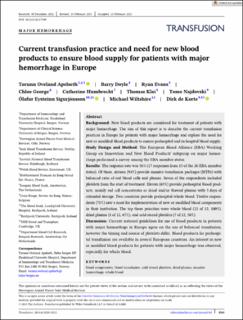| dc.contributor.author | Apelseth, Torunn Oveland | |
| dc.contributor.author | Doyle, Barry | |
| dc.contributor.author | Evans, Ryan | |
| dc.contributor.author | George, Chloe | |
| dc.contributor.author | Humbrecht, Catherine | |
| dc.contributor.author | Klei, Thomas | |
| dc.contributor.author | Najdovski, Tome | |
| dc.contributor.author | Sigurjonsson, Olafur E. | |
| dc.contributor.author | Wiltshire, Michael | |
| dc.contributor.author | de Korte, Dirk | |
| dc.date.accessioned | 2023-11-06T09:39:47Z | |
| dc.date.available | 2023-11-06T09:39:47Z | |
| dc.date.created | 2023-06-27T13:02:19Z | |
| dc.date.issued | 2023 | |
| dc.identifier.issn | 0041-1132 | |
| dc.identifier.uri | https://hdl.handle.net/11250/3100720 | |
| dc.description.abstract | Background: New blood products are considered for treatment of patients with major hemorrhage. The aim of this report is to describe the current transfusion practices in Europe for patients with major hemorrhage and explore the need for new or modified blood products to ensure prehospital and in-hospital blood supply.
Study Design and Method: The European Blood Alliance (EBA) Working Group on Innovation and New Blood Products' subgroup on major hemorrhage performed a survey among the EBA member states.
Results: The response rate was 58% (17 responses from 15 of the 26 EBA member states). Of these, sixteen (94%) provide massive transfusion packages (MTPs) with balanced ratio of red blood cells and plasma. Seven of the respondents included platelets from the start of treatment. Eleven (65%) provide prehospital blood products, mainly red cell concentrates or dried and/or thawed plasma with 5 days of extended storage. Two countries provide prehospital whole blood. Twelve respondents (71%) saw a need for implementation of new or modified blood components in their institution. The top three priorities were whole blood (12 of 12, 100%), dried plasma (8 of 12, 67%), and cold-stored platelets (7 of 12, 58%).
Discussion: Current national guidelines for use of blood products in patients with major hemorrhage in Europe agree on the use of balanced transfusion, however the timing and source of platelets differ. Blood products for prehospital transfusion are available in several European countries. An interest in new or modified blood products for patients with major hemorrhage was observed, especially for whole blood. | en_US |
| dc.language.iso | eng | en_US |
| dc.publisher | Wiley | en_US |
| dc.rights | Attribution-NonCommercial-NoDerivatives 4.0 Internasjonal | * |
| dc.rights.uri | http://creativecommons.org/licenses/by-nc-nd/4.0/deed.no | * |
| dc.title | Current transfusion practice and need for new blood products to ensure blood supply for patients with major hemorrhage in Europe | en_US |
| dc.type | Journal article | en_US |
| dc.type | Peer reviewed | en_US |
| dc.description.version | publishedVersion | en_US |
| dc.rights.holder | Copyright 2023 the authors | en_US |
| cristin.ispublished | true | |
| cristin.fulltext | original | |
| cristin.qualitycode | 1 | |
| dc.identifier.doi | 10.1111/trf.17349 | |
| dc.identifier.cristin | 2158605 | |
| dc.source.journal | Transfusion | en_US |
| dc.source.pagenumber | S105-S111 | en_US |
| dc.identifier.citation | Transfusion. 2023, 63 (S3), S105-S111. | en_US |
| dc.source.volume | 63 | en_US |
| dc.source.issue | S3 | en_US |

